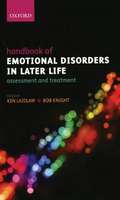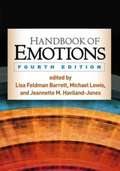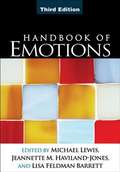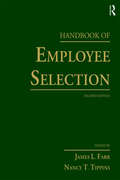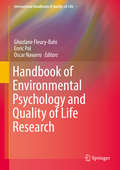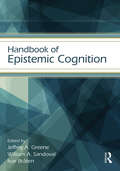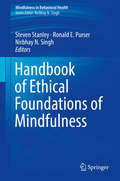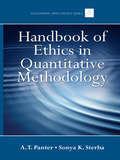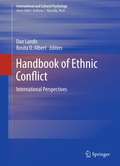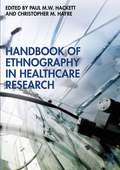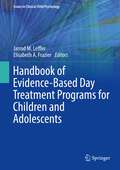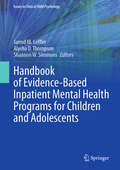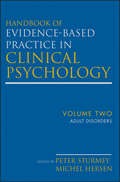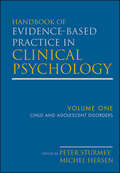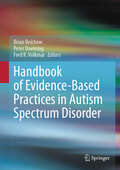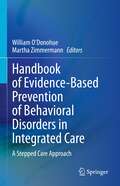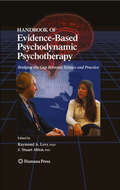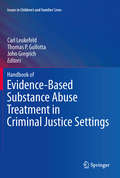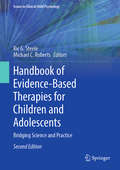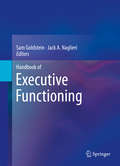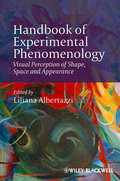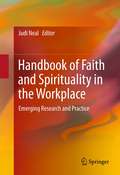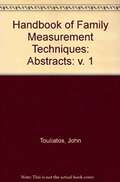- Table View
- List View
Handbook of Emotional Disorders in Later Life: Assessment and Treatment
by Bob Knight Ken LaidlawAlthough the perceptions and realities of ageing have changed markedly over the last few decades, for practitioners working with older people, emotional problems remain a major factor of health and happiness in later life. This handbook provides a concise, authoritative and up to date guide to best practice in therapy for older people, for a wide range of mental health professionals. The editors bring together chapters by experienced trainers and clinicians that cover all the significant problems and issues in the assessment and treatment of emotional disorders in later life. The introductory chapters examine the individual, social, cultural and physical experience of ageing, and provide an essential background for a caring and professional understanding of related emotional disorders and their effective treatment. Throughout the book, key research and clinical experience is reported as underlying evidence based treatment, but the emphasis is on practical guidance for assessment and interventions, rather than detailed discussion of methodological issues. With each chapter written by a specialist in their field, a range of expertise is provided in a single source, making this book an invaluable resource for anyone dealing with the mental health needs of older people.
Handbook of Emotions, Fourth Edition
by Michael Lewis Lisa Feldman Barrett Jeannette M. Haviland-JonesRecognized as the definitive reference, this handbook brings together leading experts from multiple psychological subdisciplines to examine one of today's most dynamic areas of research. Coverage encompasses the biological and neuroscientific underpinnings of emotions, as well as developmental, social and personality, cognitive, and clinical perspectives. The volume probes how people understand, experience, express, and perceive affective phenomena and explores connections to behavior and health across the lifespan. Concluding chapters present cutting-edge work on a range of specific emotions. Illustrations include 10 color plates. New to This Edition *Chapters on the mechanisms, processes, and influences that contribute to emotions (such as genetics, the brain, neuroendocrine processes, language, the senses of taste and smell). *Chapters on emotion in adolescence, older age, and in neurodegenerative dementias. *Chapters on facial expressions and emotional body language. *Chapters on stress, health, gratitude, love, and empathy. *Many new authors and topics; extensively revised with the latest theoretical and methodological innovations.
Handbook of Emotions, Third Edition
by Michael Lewis Jeannette Haviland-JonesWidely regarded as the standard reference in the field, this handbook comprehensively examines all aspects of emotion and its role in human behavior. The editors and contributors are foremost authorities who describe major theories, findings, methods, and applications. The volume addresses the interface of emotional processes with biology, child development, social behavior, personality, cognition, and physical and mental health. Also presented are state-of-the-science perspectives on fear, anger, shame, disgust, positive emotions, sadness, and other distinct emotions. Illustrations include seven color plates.
Handbook of Employee Selection
by James L. Farr Nancy T. TippinsThis second edition of the Handbook of Employee Selection has been revised and updated throughout to reflect current thinking on the state of science and practice in employee selection. In this volume, a diverse group of recognized scholars inside and outside the United States balance theory, research, and practice, often taking a global perspective. Divided into eight parts, chapters cover issues associated with measurement, such as validity and reliability, as well as practical concerns around the development of appropriate selection procedures and implementation of selection programs. Several chapters discuss the measurement of various constructs commonly used as predictors, and other chapters confront criterion measures that are used in test validation. Additional sections include chapters that focus on ethical and legal concerns and testing for certain types of jobs (e.g., blue collar jobs). The second edition features a new section on technology and employee selection. The Handbook of Employee Selection, Second Edition provides an indispensable reference for scholars, researchers, graduate students, and professionals in industrial and organizational psychology, human resource management, and related fields.
Handbook of Engineering Systems Design
by Pieter E. Vermaas Anja Maier Josef OehmenThis handbook charts the new engineering paradigm of engineering systems. It brings together contributions from leading thinkers in the field and discusses the design, management and enabling policy of engineering systems. It contains explorations of core themes including technical and (socio-) organisational complexity, human behaviour and uncertainty. The text includes chapters on the education of future engineers, the way in which interventions can be designed, and presents a look to the future. This book follows the emergence of engineering systems, a new engineering paradigm that will help solve truly global challenges. This global approach is characterised by complex sociotechnical systems that are now co-dependent and highly integrated both functionally and technically as well as by a realisation that we all share the same: climate, natural resources, a highly integrated economical system and a responsibility for global sustainability goals. The new paradigm and approach requires the (re)designing of engineering systems that take into account the shifting dynamics of human behaviour, the influence of global stakeholders, and the need for system integration. The text is a reference point for scholars, engineers and policy leaders who are interested in broadening their current perspective on engineering systems design and in devising interventions to help shape societal futures.
Handbook of Environmental Psychology and Quality of Life Research
by Ghozlane Fleury-Bahi Enric Pol Oscar NavarroThis Handbook presents a broad overview of the current research carried out in environmental psychology which puts into perspective quality of life and relationships with living spaces, and shows how this original analytical framework can be used to understand different environmental and societal issues. Adopting an original approach, this Handbook focuses on the links with other specialties in psychology, especially social and health psychology, together with other disciplines such as geography, architecture, sociology, anthropology, urbanism and engineering. Faced with the problems of society which involve the quality of life of individuals and communities, it is fundamental to consider the relationships an individual has with his different living spaces. This issue of the links between quality of life and environment is becoming increasingly significant with, at a local level, problems resulting from different types of annoyances, such as pollution and noise, while, at a global level, there is the central question of climate change with its harmful consequences for humans and the planet. How can the impact on well-being of environmental nuisances and threats (for example, natural risks, pollution, and noise) be reduced? How can the quality of life within daily living spaces (home, cities, work environments) be improved? Why is it important to understand the psychological issues of our relationship with the global environment (climatic warming, ecological behaviours)? This Handbook is intended not only for students of various disciplines (geography, architecture, psychology, town planning, etc. ) but also for social decision-makers and players who will find in it both theoretical and methodological perspectives, so that psychological and environmental dimensions can be better taken into account in their working practices.
Handbook of Epistemic Cognition (Educational Psychology Handbook)
by Jeffrey A. Greene, William A. Sandoval, and Ivar BråtenThe Handbook of Epistemic Cognition brings together leading work from across disciplines, to provide a comprehensive overview of an increasingly important topic: how people acquire, understand, justify, change, and use knowledge in formal and informal contexts. Research into inquiry, understanding, and discovery within academic disciplines has progressed from general models of conceptual change to a focus upon the learning trajectories that lead to expert-like conceptualizations, skills, and performance. Outside of academic domains, issues of who and what to believe, and how to integrate multiple sources of information into coherent and useful knowledge, have arisen as primary challenges of the 21st century. In six sections, scholars write within and across fields to focus and advance the role of epistemic cognition in education. With special attention to how researchers across disciplines can communicate and collaborate more effectively, this book will be an invaluable resource for anyone interested in the future of knowledge and knowing. Dr. Jeffrey A. Greene is an associate professor of Learning Sciences and Psychological Studies in the School of Education at the University of North Carolina at Chapel Hill. Dr. William A. Sandoval is a professor in the division of Urban Schooling at the UCLA Graduate School of Education & Information Studies. Dr. Ivar Bråten is a professor of Educational Psychology at the Faculty of Educational Sciences at the University of Oslo, Norway.
Handbook of Ethical Foundations of Mindfulness (Mindfulness in Behavioral Health)
by Nirbhay N. Singh Ronald E. Purser Steven StanleyThis handbook explores the multifaceted ethical dimensions of mindfulness, from early Buddhist sources to present-day Western interpretations of mindfulness. It takes a modern ethical approach to the study of mindfulness, and traces contemporary mindfulness practice from solitary journey to the global whole. Noted practitioners, teachers, scholars, and other professionals lend diverse perspectives to the debate over the moral content of mindfulness and its status as religious, secular, or post-secular practice. Chapters offer new views on the roots of mindfulness in Buddhist moral teachings, ethical mindfulness in interpersonal relationships, and the necessity of ethics in mindfulness-based education and therapy. Chapters also discuss current debates concerning the ethics of mindfulness across the applied fields of education and pedagogy, business, economics, and the environment. Topics featured in this handbook include: · Mindfulness as the true foundation of a naturally ethical life. · Mindfulness and its impact on emotional life, interpersonal relationships, and forgiveness. · How Buddhist ethics informs spiritual practice across the three main vehicles (yanas) of Buddhism and its relation to mindfulness. · “McMindfulness”, or the mass marketization and commodification of mindfulness-based interventions (MBIs). · How an ethic of interdependence formed by Buddhist principles and mindfulness practices can help address the environmental crisis. The Handbook of Ethical Foundations of Mindfulness is a must-have resource for researchers, clinicians/professionals, and graduate students in psychology, complementary and alternative medicine, and social work as well as occupational and rehabilitation therapy, nursing, philosophy, business management, and teachers of Buddhism and meditation.
Handbook of Ethics in Quantitative Methodology (Multivariate Applications Series)
by A. T. Panter Sonya K. SterbaThis comprehensive Handbook is the first to provide a practical, interdisciplinary review of ethical issues as they relate to quantitative methodology including how to present evidence for reliability and validity, what comprises an adequate tested population, and what constitutes scientific knowledge for eliminating biases. The book uses an ethical framework that emphasizes the human cost of quantitative decision making to help researchers understand the specific implications of their choices. The order of the Handbook chapters parallels the chronology of the research process: determining the research design and data collection; data analysis; and communicating findings. Each chapter: Explores the ethics of a particular topic Identifies prevailing methodological issues Reviews strategies and approaches for handling such issues and their ethical implications Provides one or more case examples Outlines plausible approaches to the issue including best-practice solutions. Part 1 presents ethical frameworks that cross-cut design, analysis, and modeling in the behavioral sciences. Part 2 focuses on ideas for disseminating ethical training in statistics courses. Part 3 considers the ethical aspects of selecting measurement instruments and sample size planning and explores issues related to high stakes testing, the defensibility of experimental vs. quasi-experimental research designs, and ethics in program evaluation. Decision points that shape a researchers’ approach to data analysis are examined in Part 4 – when and why analysts need to account for how the sample was selected, how to evaluate tradeoffs of hypothesis-testing vs. estimation, and how to handle missing data. Ethical issues that arise when using techniques such as factor analysis or multilevel modeling and when making causal inferences are also explored. The book concludes with ethical aspects of reporting meta-analyses, of cross-disciplinary statistical reform, and of the publication process. This Handbook appeals to researchers and practitioners in psychology, human development, family studies, health, education, sociology, social work, political science, and business/marketing. This book is also a valuable supplement for quantitative methods courses required of all graduate students in these fields.
Handbook of Ethnic Conflict
by Rosita D. Albert Dan LandisAlthough group conflict is hardly new, the last decade has seen a proliferation of conflicts engaging intrastate ethnic groups. It is estimated that two-thirds of violent conflicts being fought each year in every part of the globe including North America are ethnic conflicts. Unlike traditional warfare, civilians comprise more than 80 percent of the casualties, and the economic and psychological impact on survivors is often so devastating that some experts believe that ethnic conflict is the most destabilizing force in the post-Cold War world. Although these conflicts also have political, economic, and other causes, the purpose of this volume is to develop a psychological understanding of ethnic warfare. More specifically, Handbook of Ethnopolitical Conflict explores the function of ethnic, religious, and national identities in intergroup conflict. In addition, it features recommendations for policy makers with the intention to reduce or ameliorate the occurrences and consequences of these conflicts worldwide.
Handbook of Ethnography in Healthcare Research
by Hackett, Paul M.W.This handbook provides an up-to-date reference point for ethnography in healthcare research. Taking a multi-disciplinary approach, the chapters offer a holistic view of ethnography within medical contexts. This edited volume is organized around major methodological themes, such as ethics, interviews, narrative analysis and mixed methods. Through the use of case studies, it illustrates how methodological considerations for ethnographic healthcare research are distinct from those in other fields. It has detailed content on the methodological facets of undertaking ethnography for prospective researchers to help them to conduct research in both an ethical and safe manner. It also highlights important issues such as the role of the researcher as the key research instrument, exploring how one’s social behaviours enable the researcher to ‘get closer’ to his/her participants and thus uncover original phenomena. Furthermore, it invites critical discussion of applied methodological strategies within the global academic community by pushing forward the use of ethnography to enhance the body of knowledge in the field. The book offers an original guide for advanced students, prospective ethnographers, and healthcare professionals aiming to utilize this methodological approach.
Handbook of European Homicide Research
by William Alex Pridemore Marieke C. LiemThis comprehensive work provides a sourcebook of information about the substantive, methodological, and policy-oriented aspects of homicide research in Europe. Part one of this work covers the most recent substantive and methodological information about European homicide research. The second part will contains detailed case studies on homicide research in 15-20 individual European nations. This work will be both conceptual and practical. conceptual and practical. Conceptual aspects will focus on theoretical frameworks and patterns and trends of violence in Europe. Practical aspects will examine the results of empirical research, topics relating to different data sources and the variation of legal definitions of violence throughout Europe, and policy issues relating to variation in homicide prevention and punishment of homicide offenders throughout Europe. This handbook will not only provide an up-to-date reference that brings together known information, but will also offer previously unpublished comprehensive literature reviews and original research findings. The editors' distinctive approach is to provide readers with an English-language central source of information about the voluminous literature on European homicide research that is currently spread widely in dozens of different European and American journals.
Handbook of Evidence-Based Day Treatment Programs for Children and Adolescents (Issues in Clinical Child Psychology)
by Jarrod M. Leffler Elisabeth A. FrazierThis book examines the intermediate level of mental health services with a focus on partial hospitalization program (PHP) and intensive outpatient program (IOP) models of care for youth. It reviews the history of PHPs and IOPs and highlights their current care models, demonstrating the increase in the development and implementation of evidence-based treatment (EBT) practices. The book explores issues relating to program development, implementation, and considerations for sustainability. It provides interventions designed to enhance the well-being of youth who are experiencing a range of mental health concerns as well as strategies to engage and involve their families. In addition, the book offers feasible strategies for measuring outcomes and applying these results to meaningful clinical evaluations in PHP and IOP settings. It describes the process of accessing and using these intermediate services as well as additional treatment resources that may be necessary in the continuum of mental health care for youth. Key areas of coverage include: The history and purpose of mental health care and the role of day treatment programs for youth.Working with program administration and other stakeholders, identifying a patient population, and engaging community and referral sources.The importance of family involvement, coordination of care, and simultaneously addressing the transactional relationship between physical and mental health.Transitioning youth from pediatric mental health services into the adult mental health system.Working with a diverse patient population in intermediate treatment programs.Providing practical information for families and practitioners navigating the pediatric mental health continuum of care. The Handbook of Evidence-Based Day Treatment Programs for Children and Adolescents is a must-have resource for researchers, professors, and graduate students as well as clinicians, therapists, course instructors, and other professionals in child and adolescent psychiatry, clinical child and school psychology, social work, counseling, public health, family studies, developmental psychology, pediatrics, and all related disciplines.
Handbook of Evidence-Based Inpatient Mental Health Programs for Children and Adolescents (Issues in Clinical Child Psychology)
by Jarrod M. Leffler Alysha D. Thompson Shannon W. SimmonsThis book reviews the history of inpatient psychiatric hospital (IPH) and acute mental health services for youth. In addition, it highlights current IPH care models for children and adolescents, demonstrating an increase in the development and implementation of evidence-based-informed (EBI) treatments in IPH and acute care settings. The book offers insights into program development, implementation, and measurement as well as considerations for sustainability. Chapters describe interventions designed to enhance the well-being of youth and their families who are experiencing a range of mental health concerns. The book shares practicable strategies for measuring outcomes and applying these results to meaningful clinical outcomes in IPH and acute care settings. It also provides treatment referral resources and information about the process of accessing and using such services. Finally, the book reviews additional treatment resources that may be necessary in the continuum of mental health care for youth. Key areas of coverage include: Developing and constructing the physical and safety environment of an IPH unit and suicide and safety planning. Setting and monitoring treatment goals and discharge criteria. Equity, diversity, and inclusion considerations in psychiatric inpatient units. Program operations and therapy on a psychiatric inpatient unit for youth diagnosed with neurodevelopmental disorders. Disaster preparation and impact on inpatient psychiatric care. The Handbook of Evidence-Based Inpatient Mental Health Programs for Children and Adolescents is a must-have resource for researchers, professors, and graduate students as well as clinicians, therapists, and other professionals in developmental, clinical child, developmental, and school psychology, social work, public health, child and adolescent psychiatry, family studies, pediatrics, and all related disciplines.
Handbook of Evidence-Based Practice in Clinical Psychology, Adult Disorders
by Michel Hersen Peter SturmeyHandbook of Evidence-Based Practice in Clinical Psychology, Volume 2 covers the evidence-based practices now identified for treating adults with a wide range of DSM disorders. Topics include fundamental issues, adult cognitive disorders, substance-related disorders, psychotic, mood, and anxiety disorders, and sexual disorders. Each chapter provides a comprehensive review of the evidence-based practice literature for each disorder and then covers several different treatment types for clinical implementation. Edited by the renowned Peter Sturmey and Michel Hersen and featuring contributions from experts in the field, this reference is ideal for academics, researchers, and libraries.
Handbook of Evidence-Based Practice in Clinical Psychology, Child and Adolescent Disorders
by Michel Hersen Peter SturmeyHandbook of Evidence-Based Practice in Clinical Psychology, Volume 1 covers the evidence-based practices now identified for treating children and adolescents with a wide range of DSM disorders. Topics include fundamental issues, developmental disorders, behavior and habit disorders, anxiety and mood disorders, and eating disorders. Each chapter provides a comprehensive review of the evidence-based practice literature for each disorder and then covers several different treatment types for clinical implementation. Edited by the renowned Peter Sturmey and Michel Hersen and featuring contributions from experts in the field, this reference is ideal for academics, researchers, and libraries.
Handbook of Evidence-Based Practices in Autism Spectrum Disorder
by Fred R. Volkmar Peter Doehring Brian ReichowThe handbook examines the empirical status of interventions and treatments for individuals with autism spectrum disorder (ASD). It offers an insightful and balanced perspective on topics ranging from the historical underpinnings of autism treatment to the use of psychopharmacology and the implementation of EBPs. The book reviews the conceptualization of evidence-based practices (EBPs) as well as considerations for implementing such practices across settings. In addition, it describes emerging treatments – though they cannot yet be considered evidence-based – that have produced limited but highly promising results. The book also describes treatments and therapies that have been proved ineffective. It explores ways in which EBPs can be applied in inclusive school settings, pedatric settings, in-patient treatment progams, and college-based programs for transition-aged youth. The volume describes outcomes from the development of EBP guidelines at the national level (in Scotland) and, more broadly, in the United States and outlines how such guidelines can be adapted to offer more individualized intervention. Key areas of coverage include: Comprehensive treatment models, including early intensive behavioral intervention, pivotal response treatment, Early Start Denver Model, and Naturalistic Developmental Behavioral Interventions. Focal treatments addressing the core deficits of ASD and its co-occuring conditions. Social skills, communication, and the use of applied behavior analysis (ABA) practices for teaching new skills and decreasing challenging behaviors. Sensory-based interventions, psychopharmacology, cognitive behavior therapy, and parent education programs (e.g., Project ImPACT). The Handbook of Evidence-Based Practices in Autism Spectrum Disorder is an invaluable resource for researchers, professors, and graduate students as well as clinicians, therapists, and all professionals working in the fields of developmental, clinical child, and school psychology, pediatrics, social work, behavior analysis, allied health sciences, public health, child and adolescent psychiatry, early childhood intervention, and general and special education.
Handbook of Evidence-Based Prevention of Behavioral Disorders in Integrated Care: A Stepped Care Approach
by William O’Donohue Martha ZimmermannThis handbook is a comprehensive, authoritative and up-to-date source on prevention technologies specifically for integrated care settings. It covers general issues related to prevention including the practical issues of financing, and staffing, and a general introduction to the advantages of prevention efforts. It covers a range of behavioral health disorders using an approach that is most relevant to the practitioner: it provides basic definitions, and describes the specific roles of both the primary care provider (PCP) and the behavioral care provider (BCP) as well as specific resources presented in a stepped care model. Stepped care has been used sucessfully in medical settings. Adapted to behavioral health settings, It allows the clinician and the patient to choose treatments that are tailored to specific levels of intensity. This handbook is an interdisciplinary resource useful for classes in integrated care as well as for clinicians employed in in these settings.
Handbook of Evidence-Based Psychodynamic Psychotherapy
by J. Stuart Ablon G. O. Gabbard Raymond A. LevyThe importance of conducting empirical research for the future of psychodynamics is presented in this excellent new volume. In Handbook of Evidence Based Psychodynamic Psychotherapy: Bridging the Gap Between Science and Practice, the editors provide evidence that supports this type of research for two primary reasons. The first reason concerns the current marginalization of psychodynamic work within the mental health field. Sound empirical research has the potential to affirm the important role that psychodynamic theory and treatment have in modern psychiatry and psychology. The second reason that research is crucial to the future of psychodynamic work concerns the role that systematic empirical investigations can have in developing and refining effective approaches to a variety of clinical problems. Empirical research functions as a check on subjectivity and theoretical alliances in on-going attempts to determine the approaches most helpful in working with patients clinically. Handbook of Evidence Based Psychodynamic Psychotherapy: Bridging the Gap Between Science and Practice brings together a panel of distinguished clinician-researchers who have been publishing their findings for decades. This important new book provides compelling evidence that psychodynamic psychotherapy is an effective treatment for many common psychological problems.
Handbook of Evidence-Based Substance Abuse Treatment in Criminal Justice Settings
by Thomas P. Gullotta Carl Leukefeld John GregrichOffering lucid interpretation of data showing what works, what doesn't and what needs further study, this book probes the criminal justice system, the history of drug treatment for offenders, and the practical problems of program design and implementation.
Handbook of Evidence-Based Therapies for Children and Adolescents: Bridging Science and Practice (Issues in Clinical Child Psychology)
by Michael C. Roberts Ric G. SteeleThe comprehensive coverage in this hugely important and timely handbook makes it invaluable to clinical child, school, and counseling psychologists; clinical social workers; and child psychiatrists. As a textbook for advanced clinical and counseling psychology programs, and a solid reference for the researcher in child/adolescent mental health, its emphasis on flexibility and attention to emerging issues will help readers meet ongoing challenges, as well as advance the field. Its relevance cannot be overstated, as growing numbers of young people have mental health problems requiring intervention, and current policy initiatives identify evidence-based therapies as the most effective and relevant forms of treatment.
Handbook of Executive Functioning
by Sam Goldstein Jack A. NaglieriPlanning. Attention. Memory. Self-regulation. These and other core cognitive and behavioral operations of daily life comprise what we know as executive functioning (EF). But despite all we know, the concept has engendered multiple, often conflicting definitions and its components are sometimes loosely defined and poorly understood. The Handbook of Executive Functioning cuts through the confusion, analyzing both the whole and its parts in comprehensive, practical detail for scholar and clinician alike. Background chapters examine influential models of EF, tour the brain geography of the executive system and pose salient developmental questions. A section on practical implications relates early deficits in executive functioning to ADD and other disorders in children and considers autism and later-life dementias from an EF standpoint. Further chapters weigh the merits of widely used instruments for assessing executive functioning and review interventions for its enhancement, with special emphasis on children and adolescents. Featured in the Handbook: The development of hot and cool executive function in childhood and adolescence. A review of the use of executive function tasks in externalizing and internalizing disorders. Executive functioning as a mediator of age-related cognitive decline in adults. Treatment integrity in interventions that target executive function. Supporting and strengthening working memory in the classroom to enhance executive functioning. The Handbook of Executive Functioning is an essential resource for researchers, scientist-practitioners and graduate students in clinical child, school and educational psychology; child and adolescent psychiatry; neurobiology; developmental psychology; rehabilitation medicine/therapy and social work.
Handbook of Experimental Phenomenology
by Liliana AlbertazziWhile the scientific study of vision is well-advanced, a universal theory of qualitative visual appearances (texture, shape, colour and so on) is still lacking. This interdisciplinary handbook presents the work of leading researchers around the world who have taken up the challenge of defining and formalizing the field of 'experimental phenomenology'.Presents and discusses a new perspective in vision science, and formalizes a field of study that will become increasingly significant to researchers in visual science and beyondThe contributors are outstanding scholars in their fields with impeccable academic credentials, including Jan J. Koenderink, Irving Biederman, Donald Hoffmann, Steven Zucker and Nikos LogothetisDivided into five parts: Linking Psychophysics and Qualities; Qualities in Space, Time and Motion; Appearances; Measurement and Qualities; Science and Aesthetics of AppearancesEach chapter will have the same structure consisting of: topic overview; historical roots; debate; new perspective; methods; results and recent developments
Handbook of Faith and Spirituality in the Workplace
by Judi NealWhile the field of management has developed as a research discipline over the last century, until the early 1990s there was essentially no acknowledgement that the human spirit plays an important role in the workplace. Over the past twenty years, the tide has begun to turn, as evidenced by the growing number of courses in academia and in corporate training, and an exponential increase in the publications emerging through creative interaction of scholars and practitioners in organizational behaviour, workplace diversity, sustainability, innovation, corporate governance, leadership, and corporate wellness, as well as contributions by psychotherapists, theologians, anthropologists, educators, philosophers, and artists. This Handbook is the most comprehensive collection to date of essays by the preeminent researchers and practitioners in faith and spirituality in the workplace, featuring not only the most current research and case examples, but visions of what will be, or should be, emerging over the horizon. It includes essays by the people who helped to pioneer the field as well as essays by up and coming young scholars. Among the questions and issues addressed: · What does it mean to be a "spiritual" organization? How does this perspective challenge traditional approaches to the firm as a purely rational, profit-maximizing enterprise? · Is faith and spirituality in the workplace a passing fad, or is there a substantial shift occurring in the business paradigm? · How does this field inform emerging management disciplines such as sustainability, diversity, and social responsibility? · In what ways are faith and spirituality in the workplace similar to progressive and innovative human resource practices. Does faith and spirituality in the workplace bring something additional to the conversation, and if so, what? The aim of The Handbook of Faith and Spirituality in the Workplace is to provide researchers, faculty, students, and practitioners with a broad overview of the field from a research perspective, while keeping an eye on building a bridge between scholarship and practice.
Handbook of Family Measurement Techniques: Abstracts
by Murray A. Straus John Touliatos Barry F. PerlmutterVolume 1 includes abstracts of 976 family measurement instruments cited in the published literature 1929-1986. Abstracts in Volume 1 and 2 are preceded by overviews, written by authorities in family studies that organize and review the instruments in each chapter.
